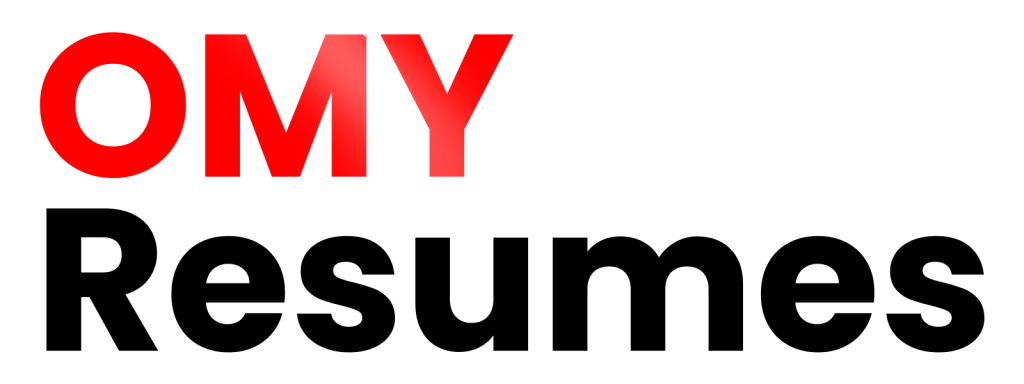How to Quantify Achievements on Your Resume: A Complete Guide for Canadian Job Seekers
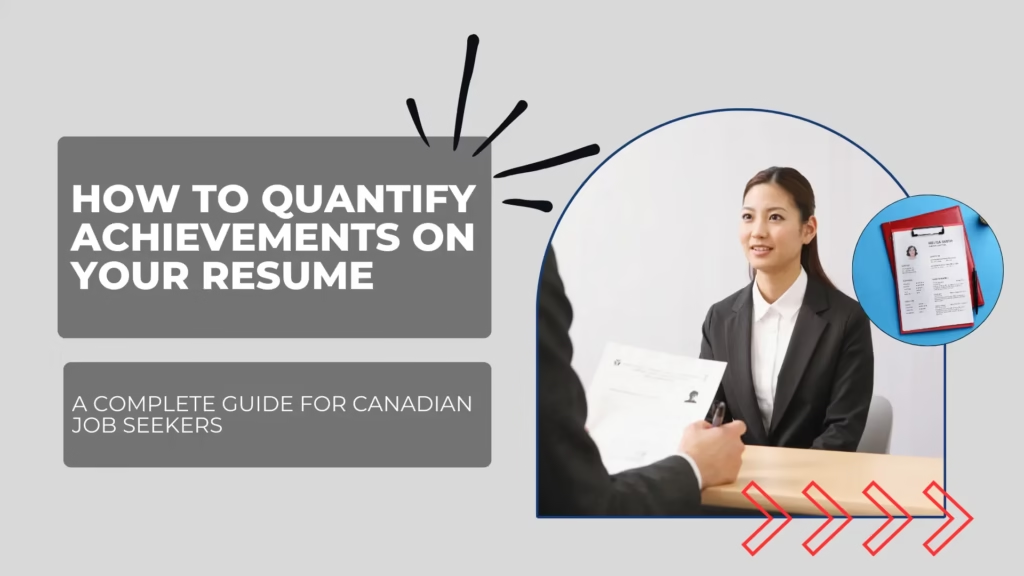
Introduction In today’s competitive Canadian job market, a resume that simply lists responsibilities no longer stands out. Employers in Toronto, Vancouver, Calgary, and beyond are increasingly using Applicant Tracking Systems (ATS) and AI tools to scan resumes for measurable impact. That means quantifying your achievements is no longer optionalit’s essential. Demonstrating your accomplishments with clear numbers, percentages, or specific outcomes tells hiring managers exactly how you can add value, making your resume much more compelling. For job seekers in 2025, this skill is crucial. Whether you’re in IT, healthcare, finance, or engineering, hiring managers want to see results, not just duties. Using measurable achievements transforms a standard resume into a high-impact, ATS-friendly resume that can outperform generic applications. In this guide, we’ll walk you through actionable strategies, real examples, and insider tips on how to quantify your achievements effectively and elevate your resume to the next level. Why Quantifying Achievements Matters on a Resume Listing responsibilities without context makes your resume blend in. Quantified achievements provide: Consider the difference between these two bullet points: The second example immediately conveys impact and results, making it much more compelling to recruiters. Start with Clear Job Metrics Identify Key Performance Indicators (KPIs) Before adding metrics, understand what your KPIs were in each role. For example: Knowing the right metrics ensures you highlight achievements that resonate with your target employers. Use Numbers Wherever Possible Numbers catch the eye. Instead of vague claims, quantify impact: Even rough estimates are better than leaving metrics out entirely. Action Verbs and Achievements Replace Responsibilities with Results-Oriented Verbs Start each bullet with strong action verbs that demonstrate impact. Examples: Example: Show Before-and-After Scenarios Highlight transformation you contributed to: This method works across all industriesfrom IT system upgrades to healthcare patient care improvements. Tailor Metrics to the Canadian Job Market Use Local Benchmarks Canadian employers often benchmark against national or provincial averages. For instance: Example: Highlight Regional Achievements Regional tailoring shows employers you understand the local market and can deliver results in that context. Quantifying Your Resume Achievements Responsibilities Start by listing all the tasks you handled in each role. This will serve as the foundation. Achievements For each responsibility, ask yourself: Gather Data Use reports, emails, or performance reviews to find actual numbers. Even estimates are better than vague statements. Method Example: Formatting Common Mistakes When Quantifying Achievements Using Generic Numbers Avoid vague metrics like “increased sales” without context. Always provide numbers, percentages, or specific outcomes. Overloading with Data Too many numbers can overwhelm. Highlight 3–5 major achievements per role for clarity. Ignoring ATS Compatibility Include metrics naturally with relevant keywords for ATS-friendly resumes. Example: Failing to Tailor Achievements Achievements should reflect the role you’re applying for. Customize for each application, especially in competitive markets like Toronto or Vancouver. Industry-Specific Quantification Examples IT Professionals Healthcare Professionals Finance Professionals Engineering Professionals Conclusion Quantifying your achievements on a resume is no longer just a nice-to-haveit’s essential for standing out in Canada’s competitive job market. By leveraging numbers, percentages, and measurable outcomes, you can demonstrate your true value to prospective employers. Whether you’re in IT, healthcare, finance, or engineering, actionable metrics convey professionalism, impact, and readiness to deliver results.
Action Verbs That Instantly Improve Your Resume
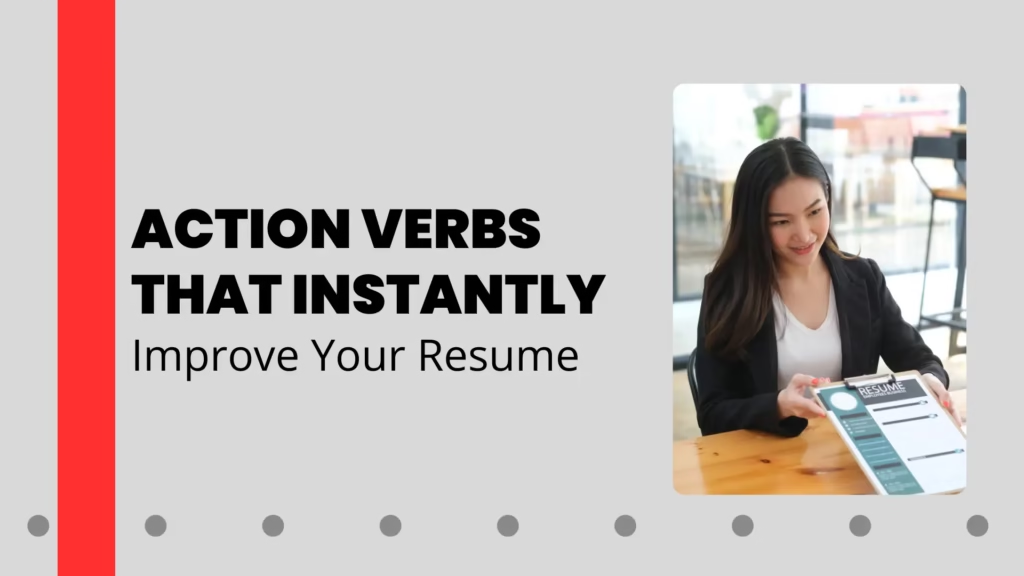
Introduction In today’s competitive Canadian job market, your resume needs more than a list of dutiesit requires action, precision, and impact. By strategically using action verbs, you can transform a bland resume into a compelling story of achievement and capability. Whether you’re applying in Toronto, Vancouver, Calgary, or Montreal, standing out to hiring managers and passing Applicant Tracking Systems (ATS) is critical. In 2025, with AI-driven recruitment tools and evolving resume trends, the right language can make the difference between a callback and rejection. This guide will explore how action verbs can instantly improve your resume, offering practical examples, Canadian job market insights, and step-by-step strategies. Whether you need help with resume writing Canada, ATS-friendly resumes, or LinkedIn optimization, these tips will help you convey professionalism, authority, and measurable results. Why Action Verbs Matter on Your Resume Action verbs do more than convey activity; they communicate impact and results. Using dynamic verbs shows employers that you are proactive, results-driven, and capable of leading projects. Consider the difference: The second example demonstrates leadership, accountability, and measurable achievementexactly what Canadian employers value. Key Benefits of Strong Action Verbs For Canadian job seekers in Toronto or Ottawa, where competition is fierce, these verbs can be the difference between landing an interview and being overlooked. Top Action Verbs to Use in Your Resume Here is a categorized list of powerful action verbs you can incorporate, tailored for various roles and industries in Canada. Leadership and Management Example: Led a team of 10 software developers in an Agile environment, achieving a 20% increase in project delivery speed. Achievements and Results Example: Achieved a 15% increase in sales revenue through strategic client engagement and upselling. Creativity and Innovation Example: Developed an AI-driven reporting tool that reduced administrative tasks by 30%. Analysis and Problem-Solving Example: Analyzed customer feedback to identify service gaps, resulting in a 25% improvement in client satisfaction. Communication and Collaboration Example: Facilitated cross-department workshops to streamline workflow processes, cutting project delays by 10%. Technical and IT Skills Example: Engineered a cloud-based system that enhanced data security and reduced server downtime by 40%. How to Choose the Right Action Verbs Match Verbs to Job Descriptions Review job postings for your target role and note keywords and verbs used. For instance, a Finance Analyst posting may emphasize verbs like analyzed, forecasted, and streamlined. Highlight Measurable Achievements Pair verbs with quantifiable results to demonstrate impact. Tailor to Industry-Specific Needs Different sectors favor different action verbs. For example: Avoiding Common Resume Mistakes Even with strong action verbs, job seekers often fall into pitfalls: Example of Poor vs. Strong Resume Bullet Revamping Your Resume with Action Verbs Audit Your Current Resume Identify weak verbs and repetitive phrasing. Step 2: Select Strong, Industry-Relevant Verbs Use categorized lists above and match to your role. Pair Verbs with Achievements Always show measurable results or clear outcomes. Optimize for ATS Incorporate verbs naturally that align with the job description. Review for Flow and Readability Ensure sentences are concise, active, and professional. Leveraging Action Verbs on LinkedIn Your online profile also benefits from strong verbs. Instead of passive phrasing, highlight accomplishments: Transforming a Toronto IT Resume Scenario: Jane, a software engineer in Toronto, had a resume with basic verbs and no measurable results. Action: We replaced generic phrases with action verbs like engineered, automated, optimized, and paired them with metrics. Outcome: Jane’s resume passed ATS filters, received interview requests from top Toronto tech firms, and ultimately landed a senior role. Trends in Resume Writing for 2025 Industry-Specific Optimization Tailoring verbs to sectors like IT, Healthcare, and Finance is more important than ever. Remote Work Considerations Action verbs demonstrating autonomy and digital collaboration (e.g., coordinated remotely, implemented cloud solutions) are increasingly valuable. Canadian Job Market Insights Integrating Action Verbs into Cover Letters Action verbs aren’t just for resumesthey enhance cover letters too. For example: Enhancing Interview Performance Action verbs also support interview preparation. Using verbs like achieved, resolved, and negotiated in your responses demonstrates confidence and results-oriented behavior. Additional Tips for Canadian Job Seekers Example: Executive Resume Bullet Points Portfolio Integration Action verbs enhance portfolio descriptions. Instead of saying “Worked on website design,” say: Conclusion Action verbs are not just wordsthey are tools that transform your resume into a story of measurable achievements, leadership, and innovation. In Canada’s competitive job market, from Toronto to Vancouver, using strong, tailored verbs can dramatically improve your chances of passing ATS filters and impressing hiring managers. By strategically choosing verbs that align with your industry, pairing them with quantifiable results, and integrating them into resumes, cover letters, and LinkedIn profiles, you position yourself as a proactive, results-driven candidate.
How to Write a Resume That Gets Noticed in 2025: A Complete Canadian Job Seeker’s Guide
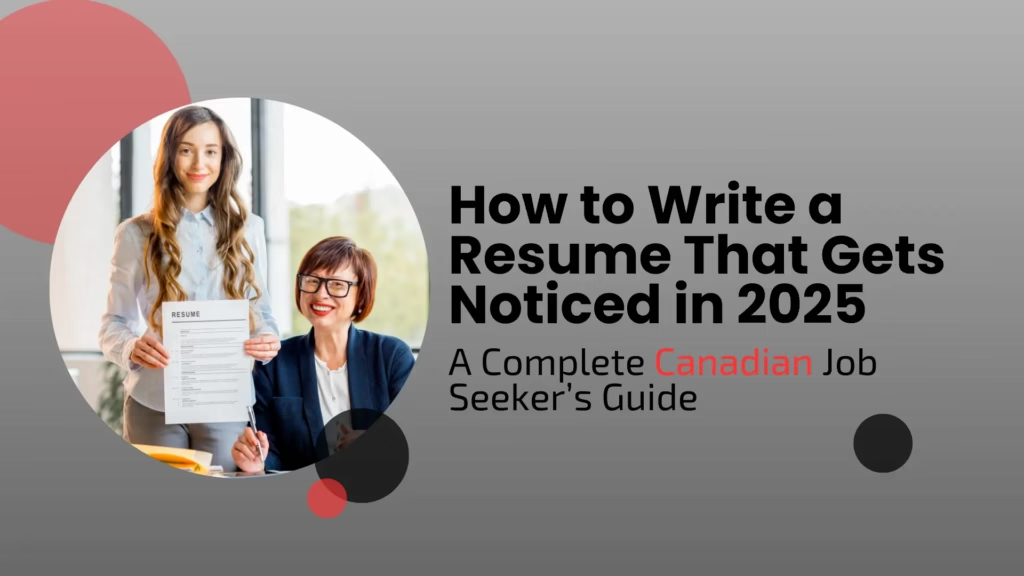
Introduction: Why Your Resume Matters More Than Ever in 2025 If you’ve been applying for jobs in Canada and hearing nothing back, you’re not alone. In 2025, the Canadian job market is more competitive, automated, and skills-focused than ever before. Employers in Toronto, Vancouver, Calgary, Montreal, and across the country are receiving hundredssometimes thousandsof applications for a single role. Before a human recruiter ever sees your application, your resume must first pass through Applicant Tracking Systems (ATS), AI screening tools, and increasingly data-driven hiring processes. For Canadian job seekers, this means one thing: the traditional resume no longer works. A generic, outdated document won’t get noticedno matter how qualified you are. Today’s resumes must be ATS-friendly, keyword-optimized, achievement-driven, and tailored to both the role and the Canadian employment market. At OMY Resumes, we work daily with professionals across industriesIT, healthcare, finance, engineering, and executive leadershipwho struggle with no callbacks, constant rejections, or unclear career direction. The good news? Once they modernize their resumes, interviews follow. In this comprehensive guide, you’ll learn exactly how to write a resume that gets noticed in 2025, using proven strategies aligned with Canadian hiring trends. Whether you’re a new graduate, mid-career professional, or executive, this guide will help you stand outand get hired. Understanding the Canadian Job Market in 2025 What’s Changed for Job Seekers in Canada? The Canadian labour market has undergone major shifts over the past few years: According to data from Job Bank Canada and Statistics Canada, industries like technology, healthcare, skilled trades, finance, and engineering continue to see high demand, while employers are becoming more selective in white-collar roles. Why ATS-Friendly Resumes Are Non-Negotiable Over 90% of medium to large Canadian employers use ATS software to filter resumes. If your resume isn’t formatted or written correctly, it may never reach a recruiter. An ATS-friendly resume: Resume Trends to Watch in 2025 1. Skills-Based and Hybrid Resumes Chronological resumes alone are no longer enough. In 2025, Canadian employers want to see what you can do, not just where you worked. Trending formats include: 2. AI-Enhanced but Human-Written Resumes Many job seekers experiment with ChatGPT for resumes, but most AI-generated resumes fail because they: 3. Keyword Optimization Is Critical Resumes must mirror job descriptions using: How to Write a Resume That Gets Noticed Start with a Powerful Resume Summary Your professional summary is prime real estate. Recruiters spend 6–8 seconds scanning a resume. Bad example: Hardworking professional with experience in customer service. Strong 2025 example: Results-driven Customer Experience Specialist with 7+ years of experience in retail and SaaS environments. Proven ability to improve client retention by 18% while managing high-volume accounts across Canada. Focus on Achievements, Not Duties Employers don’t hire responsibilitiesthey hire results. Instead of: Write: Use numbers, percentages, and outcomes wherever possible. Tailor Your Resume for Each Role One of the biggest mistakes Canadian job seekers make is sending the same resume everywhere. In 2025: Formatting Rules That Matter in 2025 ATS-Friendly Resume Formatting Checklist ✔ Use Word (.docx) or PDF (if allowed)✔ Simple fonts (Calibri, Arial, Helvetica)✔ No images, icons, or tables✔ Clear section headings✔ Consistent spacing Even strong content can fail if formatting is wrong. Industry-Specific Resume Strategies IT & Tech Resumes Canadian tech employers want: Healthcare Resumes Healthcare resumes must include: Executive Resume Tips for 2025 Executives need: A generic resume can hurt executive credibility. Common Resume Mistakes Canadian Job Seekers Make These mistakes lead directly to ATS rejections and no callbacks. Why Your Resume Must Work with Your LinkedIn Profile In 2025, recruiters always check LinkedIn. Your resume and LinkedIn profile must: Don’t Forget the Cover Letter Contrary to popular belief, cover letters still matter in Canadaespecially for government, healthcare, and professional roles. A strong cover letter: Beyond the Resume: Supporting Tools That Get You Hired Portfolio Websites Creative, tech, and consulting professionals benefit from personal portfolio sites. Mini Case Study: Toronto IT Professional Problem:Senior Developer in Toronto applying for 6 months with no interviews. Solution: Conclusion: Your Resume Is Your Career Gateway in 2025 In today’s competitive Canadian job market, your resume is no longer just a documentit’s a strategic marketing tool. With ATS systems, AI screening, and recruiter overload, only resumes that are targeted, modern, and professionally written will get noticed. Whether you’re navigating a career transition, struggling with ATS rejections, or aiming for a promotion, investing in a high-quality resume can change everything. At OMY Resumes, we specialize in creating ATS-friendly resumes, compelling cover letters, optimized LinkedIn profiles, and complete career branding solutions for professionals across Canada.
Millennial & Gen Z Job Seekers: What’s Changed in Workplace Expectations (And How to Win in Canada in 2025)
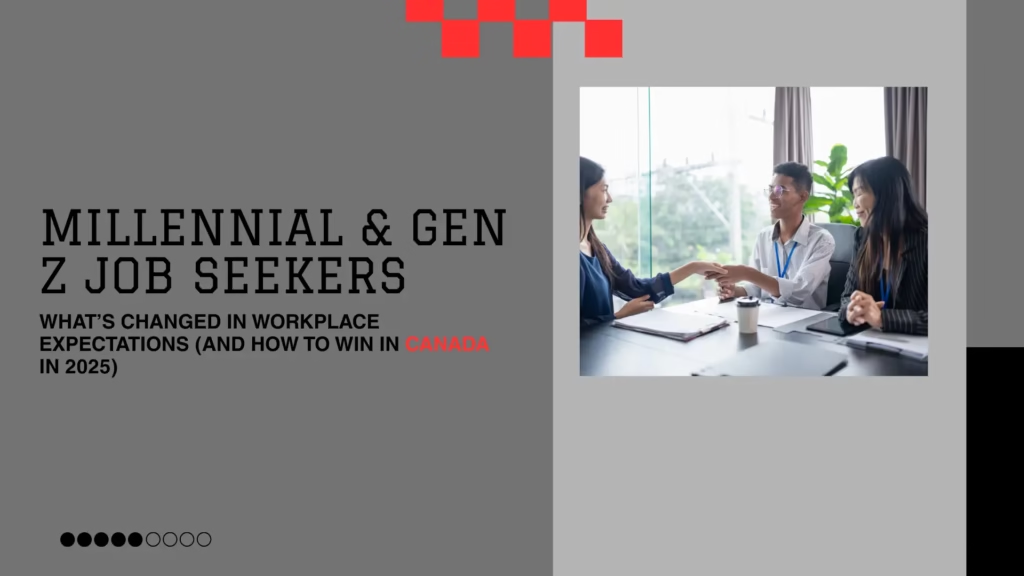
Introduction: A New Generation, A New Job Market The Canadian job market in 2025 looks nothing like it did even five or ten years ago. Millennials now make up the largest segment of the workforce, while Gen Z job seekers are entering rapidly with entirely new expectations about work, career growth, and employer relationships. Together, these generations are redefining how companies hire, manage, and retain talent and how candidates must position themselves to get hired. For Canadian job seekers, especially in competitive hubs like Toronto, Vancouver, Calgary, and Montreal, this shift has created both opportunity and frustration. On one hand, employers are more open to non-linear careers, remote work, and skills-based hiring. On the other, Applicant Tracking Systems (ATS), AI screening tools, and fierce competition mean many qualified candidates never hear back. At OMY Resumes, we work daily with Millennials and Gen Z professionals who feel stuck: sending hundreds of applications, getting rejected by ATS systems, or unsure how to communicate their value in a modern resume or LinkedIn profile. This article breaks down what’s changed, why it matters, and exactly how you can adapt with practical strategies tailored to the Canadian job market. Whether you’re a new graduate, mid-career professional, or someone navigating a career pivot, this guide will help you align your job search with today’s workplace realities. Understanding Millennials & Gen Z in the Canadian Workforce Who Are Millennial Job Seekers in 2025? Millennials (born roughly between 1981–1996) are no longer “early-career” professionals. In Canada, many now hold: Yet despite experience, many Millennials struggle with outdated resumes that don’t reflect modern hiring practices. Common pain points include: This is where ATS-friendly resumes and industry-specific resumes become essential especially in fields like IT, Healthcare, Finance, and Engineering. Who Is Gen Z And Why Are Employers Paying Attention? Gen Z (born 1997–2012) is the fastest-growing segment of entry-level and early-career talent in Canada. According to Job Bank Canada and Statistics Canada, Gen Z workers are: However, Gen Z candidates often struggle with: At OMY Resumes, we frequently help Gen Z job seekers bridge the gap between potential and presentation. What’s Changed: New Workplace Expectations in 2025 1. Flexibility Is No Longer a “Nice-to-Have” For Millennials and Gen Z, flexibility is a baseline expectation, not a perk. This includes: In cities like Toronto and Vancouver, where commute times and housing costs are high, flexibility is often a deciding factor. How this impacts your job search:Your resume and LinkedIn profile should clearly show you can thrive in flexible, autonomous environments. Highlight: 2. Purpose, Values & Employer Brand Matter More Than Salary Alone While compensation is still important, Millennials and Gen Z increasingly evaluate employers based on: Canadian employers especially in tech, healthcare, and finance now screen candidates for cultural alignment as much as technical skill. Resume tip:Include experience with: The Rise of ATS, AI & Algorithmic Hiring 3. ATS-Friendly Resumes Are Mandatory, Not Optional One of the biggest shifts affecting Millennial and Gen Z job seekers is the dominance of Applicant Tracking Systems. In Canada, over 75% of mid-to-large employers use ATS platforms to filter resumes before a human sees them. Common ATS mistakes include: . 4. AI Tools Like ChatGPT Are Changing (But Not Replacing) Resume Writing Many Gen Z job seekers now use ChatGPT for resumes and while AI can help brainstorm content, it often produces: Hiring managers can spot AI-written resumes instantly. Skills Over Titles: A Major Shift in Hiring Criteria 5. Employers Care More About Skills Than Linear Career Paths Millennials and Gen Z often change roles, industries, or even careers entirely. Canadian employers are becoming more open to this if candidates can clearly articulate transferable skills. High-demand skills in 2025 include: LinkedIn Is Now Your Second Resume 6. Why LinkedIn Optimization Is Critical for Millennials & Gen Z In 2025, recruiters in Canada rely heavily on LinkedIn for: A weak LinkedIn profile can cost you interviews even if your resume is strong. Key LinkedIn optimization areas: Portfolio Careers & Personal Branding 7. Gen Z Is Leading the Portfolio Career Movement More Gen Z professionals are building: In industries like IT, design, marketing, and engineering, portfolios often matter more than resumes alone. Canadian employers increasingly expect: Interview Expectations Have Changed Too 8. Behavioural & Values-Based Interviews Dominate Millennials and Gen Z are evaluated heavily on: Interview questions now focus on: Many candidates fail interviews not due to lack of skill, but lack of preparation. Common Mistakes Millennials & Gen Z Still Make 9. Top Job Search Mistakes to Avoid in 2025 Despite new expectations, many candidates repeat the same errors: Each of these mistakes compounds leading to no callbacks and growing frustration. Mini Case Study: Toronto Tech Professional Background:A 28-year-old Gen Z software developer in Toronto applied to over 200 roles with no interviews. Problems Identified: Solution: Result: This is a common outcome when strategy replaces guesswork. Step-by-Step Guide: How Millennials & Gen Z Can Adapt Now 10. Your 2025 Job Search Action Plan OMY Resumes supports job seekers across Canada from Toronto to Calgary, Ottawa, Vancouver, and beyond. Conclusion: The Future of Work Belongs to the Prepared Millennials and Gen Z job seekers are not “entitled” or “job-hopping” they are simply responding to a workplace that has changed dramatically. Flexibility, purpose, skills-based hiring, AI-driven recruitment, and personal branding are now the norm in Canada’s job market. The candidates who succeed in 2025 are not necessarily the most experienced they are the most strategic. They understand how ATS systems work, how recruiters think, and how to present their value clearly and confidently.
Time Management Tools for Job Seekers: Productivity Strategies for Faster Career Success in 2025
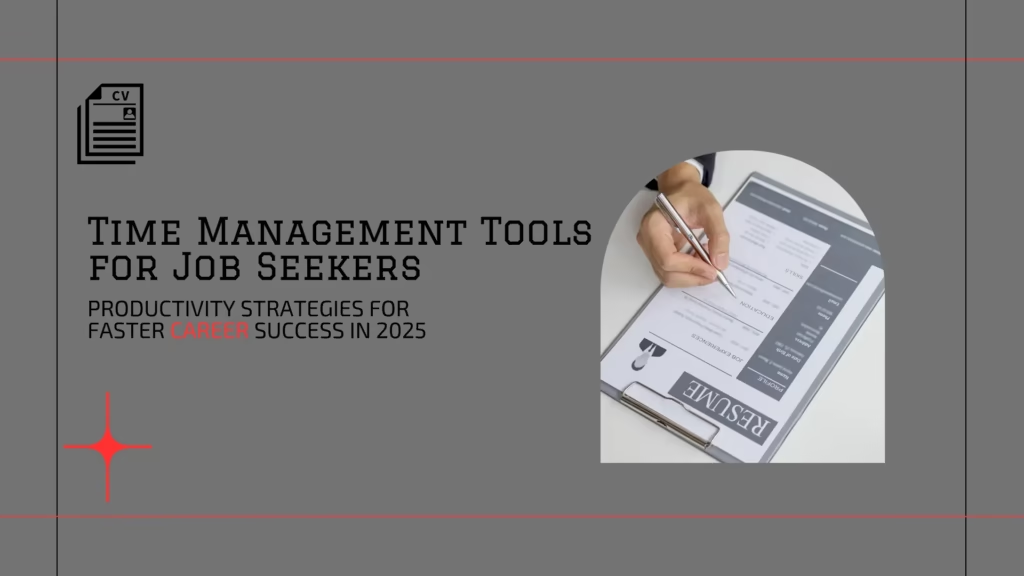
Job searching in 2025 is no longer a passive process. Canadian employers move quickly, competition is fierce, and AI-powered Applicant Tracking Systems scan thousands of applications daily. If you’re not organized, consistent, and strategic with how you manage your time, you’re already falling behind even if your resume is strong. For many job seekers across Toronto, Vancouver, Calgary, Montreal, Ottawa, and beyond, the biggest challenge isn’t a lack of skills. It’s feeling overwhelmed, scattered, or unsure of how to prioritize the daily tasks that lead to real progress. Between customizing resumes, applying through job boards, networking on LinkedIn, preparing for interviews, and learning new skills, searching for a job can feel like a full-time job itself. That’s why time management tools and productivity systems have become essential for job seekers in Canada. When used correctly, these tools help streamline your applications, track opportunities, stay consistent, and reduce the frustration of “no callbacks.” Combined with expert support such as resume writing in Canada, LinkedIn optimization, and career consultation, time management tools can dramatically increase your chances of landing interviews faster. This guide breaks down the best tools, tips, and strategies for Canadian job seekers from digital planners to AI tools like ChatGPT, to industry-specific workflow systems. You’ll learn how to work smarter, not harder, throughout your job search. Why Time Management Matters for Job Seekers in Canada The Reality of Job Searching in 2025 According to Job Bank Canada, the competition for many roles especially in major cities like Toronto and Vancouver has increased as more candidates pursue remote or hybrid positions. In high-demand industries such as IT, healthcare, finance, and engineering, applicants often apply to 50–100 jobs before securing interviews. Here’s why time management tools are essential: Canadian job seekers who use structured systems report feeling more confident, staying consistent, and landing interviews faster. Let’s dive into the strategies and tools that can help you stay ahead. Use a Job Search Tracker (Your Essential Productivity Backbone) A job search tracker is the foundation of effective time management. Using a spreadsheet, Notion template, or app allows you to record: Recommended Tools Notion – Highly customizable, ideal for detailed trackers.Google Sheets – Simple, free, and easy to update on any device.Airtable – Perfect for visual job pipeline tracking (Kanban boards, filters, etc.). Canadian Case Study: Sara (Toronto job seeker) Sara applied to 112 marketing roles in 2024 and didn’t receive many callbacks. After creating a Notion tracker with tailored resume versions and follow-up reminders, she landed 6 interviews in 30 days. The Pomodoro Technique for Job Seekers Job searching can feel endless, but focused bursts of work keep you on track. How It Works What to Use It For Recommend Apps AI Tools Like ChatGPT: Your Productivity Assistant AI isn’t going away it’s becoming one of the most helpful time-saving tools for job seekers. Many Canadians already use ChatGPT for resumes, cover letters, and interview practice. What AI Can Help With What AI Should Not Replace Use Calendar Blocking to Structure Your Job Search Calendar blocking creates a predictable routine crucial for motivation and burnout prevention. Daily Schedule Example 9:00–10:00 AM: Search for new job postings10:00–11:00 AM: Tailor resumes and cover letters11:00–11:30 AM: LinkedIn networking1:00–2:00 PM: Apply to 3–5 strategic jobs2:00–3:00 PM: Skill-building (e.g., Coursera, Udemy, LinkedIn Learning)3:00–4:00 PM: Follow-ups and application updates Tools Use Automation to Reduce Manual Work If you’re manually checking job boards, you’re wasting valuable time. Automation can streamline this. Tools to Automate Your Job Search You can also set up email templates for: Automation saves hours per week time you can reinvest in preparing for interviews or improving your resume. Optimize Your LinkedIn Workflow Using Time Management Tools LinkedIn remains the #1 platform for professional networking in Canada. However, most job seekers don’t use it strategically. Daily 15-Minute LinkedIn Routine Tools for Enhancing Productivity 7. Digital Planners and Job Search Apps That Keep You Organized Top Planners for 2025 Why Job Seekers Love Them Digital planners help you visually track your journey something many job seekers underestimate. Upskilling: Manage Time by Learning the Right Skills The Canadian job market is quickly evolving. Statistics Canada highlights a growing skill demand in AI, cybersecurity, healthcare, and finance. Top Online Learning Platforms Time Management Tip Allocate one hour per day or five hours per week to skill-building. This is especially helpful for job seekers in fields like IT or engineering, where industry-specific certifications can significantly increase competitiveness. How to Organize Your Resume Versions (Advanced Productivity Tip) Many Canadian job seekers lose time rewriting resumes from scratch. A better strategy is to create resume clusters. Resume Clusters Example For IT professionals: For healthcare professionals: This system saves dozens of hours. Time Management Mistakes Canadian Job Seekers Should Avoid Even organized job seekers fall into these traps: Applying to too many jobs without strategy Instead, apply to 5–7 targeted roles per day. Using the same resume everywhere ATS systems in 2025 demand customization. Focusing only on online applications Networking increases job success by over 60%. Not preparing early for interviews Interview readiness starts from day one. Build a Professional Portfolio (Time-Saving Tip for Creative and Tech Roles) In industries like design, IT, marketing, and engineering, a portfolio helps hiring managers assess your skills quickly. Tools for Portfolio Creation How to Use Time Management Tools to Improve Interview Preparation Tools to Practice Efficiently Daily Routine Example Set Weekly Job Search Goals Successful job seekers set measurable goals. Sample Weekly Goals Tracking goals creates momentum and prevents stagnation. Use Canadian Job Market Insights to Guide Your Time Management According to LinkedIn’s 2025 Jobs Report and Job Bank Canada: Knowing where opportunities exist helps you prioritize your time and avoid wasting energy on roles with low demand. Conclusion: Take Control of Your Job Search with the Right Tools and Expert Support Time management is more than staying organized it’s the key to standing out in a competitive Canadian job market. Whether you’re applying for roles in Toronto, Montreal, Vancouver, Ottawa, or anywhere else in
Digital Branding: Your Resume Across Social Media Why Consistency Matters More Than Ever in 2025
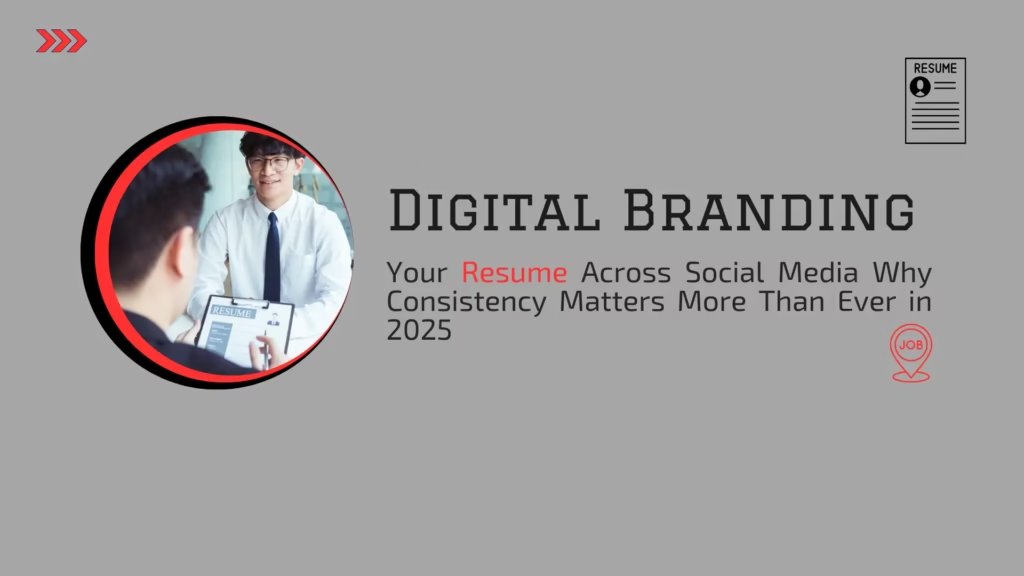
In the 2025 Canadian job market, your résumé is no longer just a one-page document—it’s a digital identity that lives and breathes across platforms. Employers now review a candidate’s LinkedIn profile before they even open a résumé. Recruiters in Toronto, Vancouver, Calgary, and Montreal routinely scan portfolios, social media accounts, industry forums, and even personal websites to confirm whether a candidate’s story feels credible and consistent. This shift has changed the hiring landscape. Job seekers who once relied on a polished PDF now need a unified digital presence that tells the same story everywhere. Whether you’re applying for a Software Developer role in Toronto’s tech corridor, a Nursing position in Ottawa, or a Finance role in Calgary, consistency across your résumé, LinkedIn profile, portfolio website, and social media signals professionalism and reliability. Yet many Canadians still struggle with digital branding. They apply with an ATS-friendly résumé, but their LinkedIn headline is outdated. Their portfolio highlights different skills than their résumé. Their social media presence feels casual or incomplete. These mismatches raise red flags for employers and directly affect callback rates—even when the candidate is qualified. In this guide, OMY Resumes (Canada’s leader in resume writing, LinkedIn optimization, and career consultation) dives deep into digital branding strategy for 2025. You’ll learn how to align your résumé with your online footprint, avoid common inconsistencies, and create a compelling professional narrative that enhances your job-search success from coast to coast. Understanding Digital Branding in 2025: More Than Just a LinkedIn Profile Digital branding refers to the way you present yourself online in relation to your career. It includes: In today’s hiring process, recruiters don’t just look at what you say—they look at where you say it and how consistently you say it. Why Canadian Recruiters Now Expect a Digital Brand According to LinkedIn’s 2024 Hiring Trends Report, over 75% of Canadian recruiters review candidate social profiles as part of their screening. Job Bank Canada reported that over 90% of employers now prefer candidates who maintain up-to-date LinkedIn profiles, especially in competitive fields like: If your digital branding is inconsistent—missing dates, conflicting job titles, different summaries—recruiters may assume you’re: A cohesive digital brand eliminates these doubts immediately. The Resume as Your Core Digital Identity Your résumé is still the foundation of your career story—even in the age of AI and digital profiles. At OMY Resumes, we design ATS-friendly resumes built to pass Applicant Tracking Systems used across Canada. But what many job seekers overlook is that once your résumé makes it past the ATS, hiring managers immediately compare it to your online presence. What Must Match Across All Platforms The following elements must be identical across your résumé, LinkedIn, and portfolio: Even small inconsistencies—such as listing “Marketing Specialist” on LinkedIn and “Digital Marketing Coordinator” on your résumé—raise questions. How ATS-Friendly Resumes Lead into Digital Branding If you want to strengthen your résumé before aligning everything else, start with OMY Resumes’ Professional Resume Writing Services: A strong, modern résumé becomes the anchor for your entire digital identity. LinkedIn as Your Most Powerful Digital Branding Tool LinkedIn is no longer optional. It is the single most important online platform for your career. In industries like IT, Engineering, Healthcare, Finance, Education, and Sales, recruiters rely on LinkedIn as their primary talent sourcing tool. The 2025 LinkedIn Optimization Checklist To stand out in the Canadian job market, ensure these elements are optimized: Your Portfolio or Personal Website: The New Digital Resume A digital portfolio is no longer just for designers or developers. In 2025, candidates in: …all benefit from an online space to showcase their accomplishments. What a Professional Portfolio Should Include A Canadian-focused portfolio should feature: Social Media & Professionalism: What Recruiters Actually Check Recruiters often look at your public online activity to confirm: What’s Safe to Keep Public You can keep these public if they’re aligned with your professional identity: What Should Be Private Anything political, controversial, unprofessional, or personal should be locked down. Creating a Unified Digital Brand in 2025 (Step-by-Step Guide) Here’s a structured plan used by OMY Resumes during our Career Consultation sessions: Start with Your Resume Fix inconsistencies first. Ensure dates, job titles, and skills are correct. Align LinkedIn with Your Resume Reword, don’t copy. LinkedIn is conversational, not formal. Update Your Portfolio Add projects with real metrics. Example: Clean Up Social Media Google your name. See what comes up. Remove or hide anything irrelevant or unprofessional. Add Consistent Branding Elements Leverage AI Tools (the Right Way) ChatGPT for resumes, AI résumé builders, and grammar tools are helpful—but should never fully replace a human writer. Many AI tools produce generic or inaccurate content. OMY Resumes often revises “AI-generated resumes” to make them recruiter-ready. Digital Branding Mistakes Canadians Make (And How to Fix Them) Using Different Job Titles Across Platforms Fix: Standardize titles across résumé, LinkedIn, and portfolio. Incomplete or Outdated LinkedIn Profiles Fix: Update your About section yearly. Overly Casual Social Media Fix: Keep professional posts on public profiles. Conflicting Career Stories Fix: Define a clear personal brand and stick to it. Weak Portfolio or No Portfolio Fix: Build a simple, professional showcase of your work. Mini Case Studies from the Canadian Job Market Case Study 1 IT Professional in Toronto “Mark,” a software developer, had: Recruiters ignored his applications.OMY Resumes helped him: Nurse in Vancouver “Amira,” an experienced RN, struggled with: After updating everything to match Canadian healthcare resume standards, she secured interviews at two major Vancouver hospitals. Executive in Montreal A senior finance leader required consistent branding across: After optimizing everything, he received a CFO offer in Quebec within 60 days. Digital Branding for Industry-Specific Careers OMY Resumes provides specialized resume services for Canadian sectors like: Industry resumes must align with your LinkedIn narratives and portfolio examples. Location-Specific Branding for Canadian Cities Toronto’s job market differs from Calgary’s. Vancouver isn’t Montreal. If you’re applying in outreach-heavy markets, use location-focused keywords in your LinkedIn profile such as: Conclusion: Strengthen Your Digital Brand and Transform Your Job Search Canadian hiring in
SkillBuilding on the Side: How to Show Growth Courses, Projects to Boost Your Resume
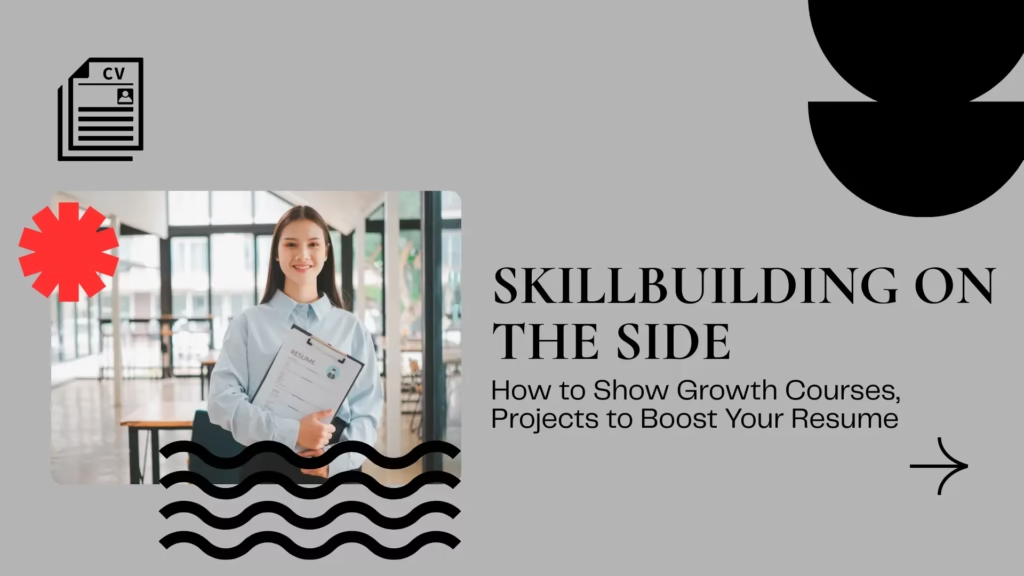
Introduction In today’s competitive Canadian job market, simply having a degree or years of experience isn’t enough. Employers increasingly seek candidates who demonstrate continuous growth and adaptability. Whether you’re in Toronto, Vancouver, or Montreal, showing initiative through side projects, online courses, and professional development can set your resume apart in 2025. With the rise of AI resumes and ATS systems, it’s no longer just about listing skills—it’s about proving you’ve actively expanded your expertise. This guide explores practical ways to boost your resume, highlight skillbuilding efforts, and position yourself as a forwardthinking professional. From resume writing Canada strategies to optimizing your LinkedIn profile, we cover everything job seekers need to stay competitive. Why SkillBuilding Matters for Canadian Job Seekers The Canadian job market has seen a shift towards continuous learning. According to Job Bank Canada, employers increasingly value candidates who demonstrate ongoing skills development, particularly in industries like IT, Healthcare, Finance, and Engineering. Side projects, certifications, and online courses are tangible evidence that you are proactive and adaptable. Moreover, ATSfriendly resumes prioritize measurable skills and relevant experiences. Incorporating skillbuilding efforts can enhance your resume services Toronto submission and make you stand out during screening. Identify InDemand Skills Research Industry Trends Before investing time in skillbuilding, identify which competencies are most valuable. Use sources like: For example, in IT, cloud computing and cybersecurity are highly sought after, while in Healthcare, digital health literacy and patient data management are gaining importance. Assess Your Current Skill Gaps Conduct a selfaudit of your resume: Take Online Courses Strategically Choose Courses That Add Real Value Platforms like Coursera, LinkedIn Learning, and Udemy offer certifications that can enhance your resume. Canadian employers often appreciate courses from recognized institutions, especially those that culminate in certifications or projects. Pro Tip: Select courses that include practical projects. These can be showcased on your resume or portfolio, demonstrating applied knowledge rather than just theoretical understanding. Highlight Courses on Your Resume Create a section like “Professional Development” or “Certifications”. Example: This approach works well in industryspecific resumes and can strengthen applications for roles requiring specialized skills. Engage in Side Projects Why Side Projects Matter Side projects are tangible proof of your skills. They demonstrate initiative, problemsolving, and the ability to complete tasks independently. MiniCase Study:A Torontobased software developer created an opensource project for automating small business workflows. When applying for a senior IT role, including this project in their ATSfriendly resume led to multiple interview invitations within weeks. Types of Side Projects Freelancing and Gig Work Gain RealWorld Experience Freelancing or participating in gig work allows you to: Platforms like Upwork or Fiverr are valuable, but local Canadian opportunities can also enhance your network and credibility. How to Document Freelance Work Include freelance projects under your professional experience with metrics and outcomes: This is particularly effective for roles in IT, Marketing, and Design. Volunteer and Community Projects SkillBuilding Through Volunteer Work Volunteering in Canada can strengthen skills like leadership, project management, and communication. Consider: Example: A Montreal finance graduate volunteered as a tax assistant for seniors, gaining accounting experience that boosted their executive resume. Presenting Volunteer Work on Your Resume Leverage Certifications CanadianRecognized Credentials Certifications can signal credibility to employers. Examples: Adding certifications to your resume writing Canada portfolio shows dedication to career growth and learning. H3: How to Feature Certifications Create a separate section or integrate them under relevant roles. Example: Optimize LinkedIn and Online Presence LinkedIn Optimization Tips A polished LinkedIn profile can complement your resume: Personal Branding Through Portfolios Link to a portfolio showcasing side projects or freelance work. This adds credibility and demonstrates applied skills beyond your resume. Avoid Common Mistakes Overloading Your Resume Too many skills or projects can dilute impact. Focus on: Listing Skills Without Proof Avoid generic skills. Pair them with projects, results, or certifications to show tangible evidence. Ignoring ATS Optimization Use keywords from job postings to ensure your ATSfriendly resume passes automated screening. This is crucial in competitive markets like Toronto Case Studies: SkillBuilding Success Stories IT Professional in Toronto Healthcare Worker in Calgary Finance Graduate in Montreal StepbyStep Guide to Showing Growth on Your Resume Additional Tips for 2025 Leveraging IndustrySpecific Strategies This approach strengthens executive resume tips and ensures your profile is tailored to the Canadian market. Combining Resume, Cover Letter, and Online Profiles A holistic approach ensures consistency: This strategy maximizes your visibility and appeal to Canadian employers. Conclusion In 2025, standing out in Canada’s competitive job market requires more than experience—it demands visible growth, adaptability, and initiative. By strategically engaging in courses, side projects, volunteering, and certifications, you can boost your resume, demonstrate continuous learning, and make a strong impression on employers. OMY Resumes offers comprehensive services to help Canadian job seekers showcase their skills effectively. From resume writing Canada and ATSfriendly resumes to LinkedIn optimization, cover letter writing, and interview preparation, our team ensures you present your growth story convincingly. Whether you’re in Toronto, Calgary, or Vancouver, our expertise positions you for success.
Answering ‘Tell Me About Yourself’ – Structuring Your Resume Pitch for Maximum Impact
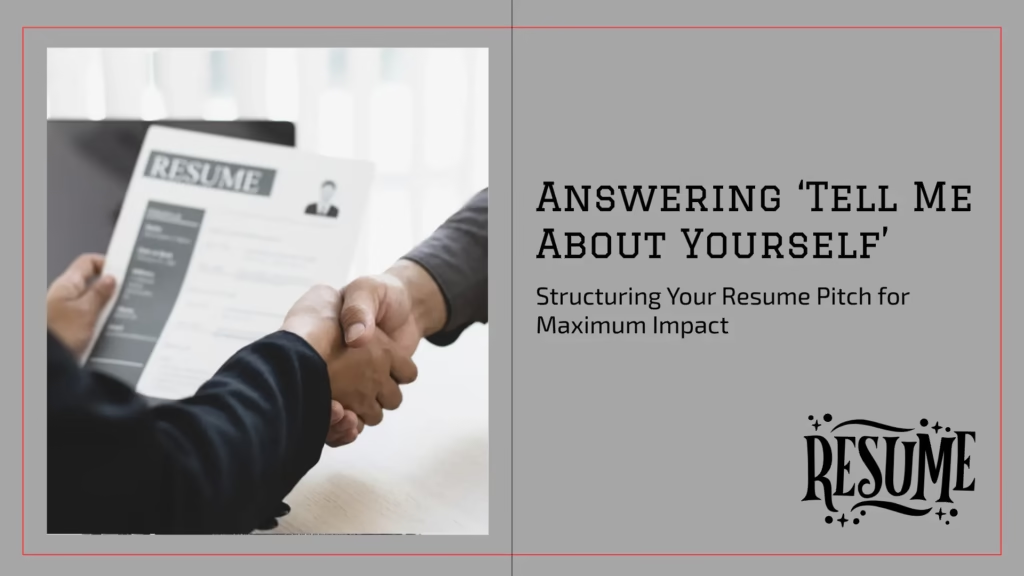
Introduction If you’re a Canadian job seeker navigating the competitive job market in 2025, you’ve likely encountered the dreaded opening interview question: “Tell me about yourself.” While it may sound simple, this question is often a make-or-break moment. Hiring managers in Toronto, Vancouver, Ottawa, and across Canada are not just listening for a generic career summary—they want a concise, compelling pitch that demonstrates your skills, experience, and fit for the role. Crafting an effective response is more than rehearsing a few sentences. It’s about structuring a resume-introduction pitch that seamlessly ties your professional background to the employer’s needs. With trends like AI-driven resumes, LinkedIn optimization, and industry-specific resume strategies shaping hiring practices, job seekers must deliver a clear, strategic, and memorable introduction. In this guide, we’ll break down how to answer “Tell me about yourself” with authority, providing practical examples, tips, and step-by-step guidance for Canadian professionals. Whether you’re an entry-level candidate in IT, a seasoned healthcare professional, or an executive in finance, you’ll learn how to structure your pitch to impress interviewers and get the callbacks you deserve. Why a Strong “Tell Me About Yourself” Response Matters The opening question sets the tone for the rest of the interview. A strong response can: Common mistakes include rambling, over-sharing personal details, or reading directly from your resume. In Canada’s competitive job market, these missteps can be costly. H2: Understanding the Purpose of the Question H3: What Employers Are Really Asking Employers want to quickly understand: Why It’s More Than a Resume Recap Simply summarizing your resume can make you blend in with dozens of other candidates. Instead, your pitch should: For example, instead of saying, “I worked in IT for five years,” say: “I’ve spent the last five years designing secure, scalable cloud solutions for mid-sized businesses in Toronto, resulting in a 30% reduction in downtime for clients.” Structuring Your Pitch – The Three-Part Formula Present Your Professional Identity Start with your current role and professional focus. Keep it relevant to the job. Example: “I’m a healthcare project manager specializing in digital transformation initiatives for hospitals across Ontario.” Highlight Key Achievements Include 2-3 concise achievements that demonstrate impact. Example: “In my previous role, I led a team of 10 to implement an electronic health records system, improving patient data accuracy by 25%.” Connect to the Role or Company End by tying your experience to why you’re a strong fit. Example: “I’m excited about this opportunity at XYZ Hospital because of its commitment to innovative patient care, and I’d love to contribute my expertise in digital health projects.” This three-step structure ensures your answer is strategic, memorable, and tailored. Tips for Crafting Your Answer Keep It Concise Aim for 90-120 seconds. Avoid rambling. Practice trimming unnecessary details. Use Metrics and Results Numbers make your achievements tangible and credible. Example: “Boosted website traffic by 60% through SEO optimization for a Toronto-based fintech startup.” Adapt for Different Industries Align With Your Resume and LinkedIn Consistency builds credibility. Ensure your pitch reflects your and Avoid Overused Phrases Steer clear of clichés like: Instead, show evidence through achievements. Practice, Don’t Memorize Practice allows flexibility and natural delivery. Record yourself to spot awkward phrasing. Incorporating Resume Trends 2025 AI and ChatGPT in Resume Creation AI tools can help draft tailored responses and highlight key skills. However, your pitch must remain human and authentic. Pro Tip: Integrate insights from AI resumes but personalize examples for Canadian employers. ATS-Friendly Resumes Ensure your pitch mirrors keywords from your resume, making it ATS-friendly. Mention relevant tools, certifications, and skills. Industry-Specific Optimization Use language and metrics relevant to your field. For executives, emphasize leadership; for IT, highlight technical expertise and project outcomes. Common Mistakes to Avoid Case Studies Case Study 1 – IT Professional in Toronto Scenario: Mid-level IT professional struggling to land interviews. Problem: Answered “Tell me about yourself” vaguely. Solution: Structured pitch highlighting cloud migration projects and measurable outcomes. Result: Received interviews at three top Toronto tech firms. Case Study 2 – Healthcare Manager in Ottawa Scenario: Experienced healthcare manager applying for a digital health initiative. Solution: Linked achievements to hospital efficiency improvements and patient care metrics. Result: Secured an executive interview. Guide to Craft Your Answer Integrating Cover Letters and LinkedIn Your pitch should complement your and. Key points: Regional Considerations in Canada Job seekers in Toronto, Vancouver, Ottawa, Calgary, and Montreal should consider local market trends: Adapting your pitch to regional trends increases relevancy and impact. Additional Resources for Job Seekers Conclusion Mastering the “Tell me about yourself” question is no longer optional in Canada’s competitive 2025 job market. A well-structured pitch can transform a standard interview into a memorable conversation that highlights your achievements, skills, and potential cultural fit. By following the three-part structure, incorporating metrics, and tailoring your response to your industry and location, you increase your chances of landing callbacks and advancing in your career.
International Applicants: How to Write a Resume for a Canadian Employer (2025 Guide for Newcomers)
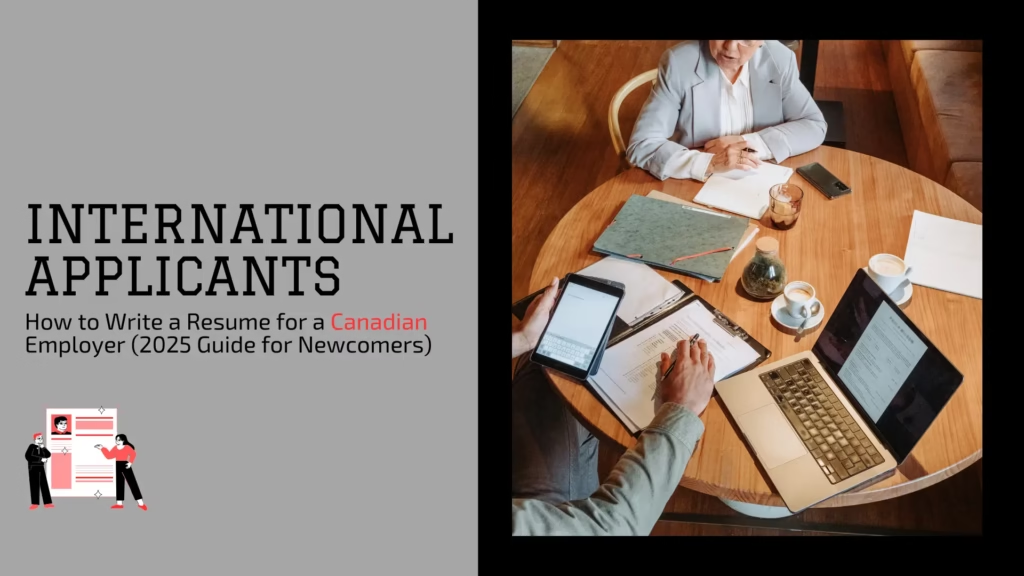
Breaking into the Canadian job market as a newcomer can feel overwhelming especially when your existing CV doesn’t match what Canadian employers expect. Whether you recently landed in Toronto, Vancouver, Calgary, Ottawa, Montreal, or you’re preparing to move to Canada, the way you present your professional story matters more than ever in 2025. Recruiters are now using more advanced ATS (Applicant Tracking System) filters, AI-powered screening tools, and stricter formatting requirements. Many international applicants don’t receive callbacks not because they aren’t qualified but because their resumes simply don’t follow Canadian resume standards. In this comprehensive guide, we break down exactly how to create a Canadian-style resume that gets noticed. You’ll learn what employers in Canada look for, how to avoid the most common mistakes newcomers make, how to showcase your international experience effectively, and how to align your resume with 2025 hiring trends. As a trusted authority in resume writing in Canada, OMY Resumes supports newcomers every day in transforming international CVs into Canadian-ready, ATS-friendly resumes that land interviews. This guide reflects real hiring insights, recruiter feedback, and practical strategies tailored for newcomers entering the Canadian workforce. Understanding the Canadian Job Market in 2025 Canada continues to welcome thousands of skilled immigrants every year. But the hiring landscape has evolved, and competition is higher especially in large cities like Toronto, Vancouver, Calgary, Montreal, and Ottawa. Trends Newcomers Need to Know According to Job Bank Canada and Statistics Canada, industries such as technology, healthcare, professional services, supply chain, construction, and financial services are projected to experience strong growth through 2025. For newcomers, this means opportunity but only with the right resume strategy. What Makes a Resume “Canadian Style”? Many international applicants are surprised at how different Canadian resumes are from CVs in Europe, the Middle East, Asia, Latin America, or Africa. Canadian resumes DO NOT include: A Canadian resume SHOULD include: Tip: If your current CV looks crowded, academic, or overly detailed, a Canadian employer may skip it immediately even if you are highly qualified. For help aligning your format to Canadian standards, explore our. The Biggest Mistakes International Applicants Make Newcomers often have strong experience but unknowingly present it in ways Canadian employers don’t understand. Here are the most common resume mistakes we fix at OMY Resumes: 1. Using a CV Instead of a Resume Canadian employers expect a resume, not a CV, unless you’re applying for: Most newcomers submit 3–6 page CVs, which get rejected immediately. 2. Listing Tasks Instead of Achievements International resumes often list responsibilities like: “Responsible for managing a team of five engineers.” A Canadian resume needs results: “Led a team of 5 engineers to deliver 12+ infrastructure upgrades, improving system uptime by 18%.” 3. Using non-Canadian terminology Instead of “Programme Manager,” use “Program Manager”.Instead of “CV,” use “Resume.” Even job titles like “Executive Secretary,” “In-charge,” or “Officer” may need to be adapted to Canadian equivalents. 4. Overly formal writing (common in international CVs) Avoid phrases like: Canadian resumes are simple, results-driven, and factual. 5. Poor formatting that ATS cannot read PDFs with tables, text boxes, icons, and columns often break in ATS. If your resume isn’t ATS-friendly, job portals like Indeed, LinkedIn, Monster, and Government of Canada Job Bank may reject it. Our team specializes in ATS-compliant formats through our. How to Format an ATS-Friendly Canadian Resume in 2025 Formatting can make or break your application especially for newcomers. Canadian Resume Structure (2025 Standard) Formatting Rules to Follow ATS-Friendly Resume Example (Excerpt) Senior Business Analyst | IT & Financial ServicesToronto, ON | 8+ years experience | PMP Certified Professional SummarySenior Business Analyst specializing in process improvement, data analytics, and enterprise systems. Delivered $1.2M+ in savings through automation initiatives. Experienced in stakeholder management across cross-functional teams in IT and Finance. Core SkillsBusiness Analysis • Agile/Scrum • Data Visualization • SQL • Systems Integration • Process Optimization • Stakeholder Management Professional ExperienceBusiness Analyst – FinTech Corp, Toronto2019–Present This format is clear, concise, and matches Canadian employer expectations. Writing a Powerful Professional Summary (For Newcomers) In Canada, your Professional Summary is the most important section of your resume. It replaces the old “Career Objective,” which is no longer used. A newcomer-friendly Professional Summary should: Example for newcomers in IT Software Developer with 5+ years experience across FinTech and SaaS environments. Skilled in full-stack development, cloud architecture, and Agile delivery. Delivered multiple high-traffic applications and optimized system performance. Seeking to contribute to a Toronto-based technology team. Example for newcomers in Healthcare International Registered Nurse with 7 years acute care experience in cardiology and emergency units. Strong patient care, assessment, and EMR documentation skills. Currently completing required licensing steps for RN practice in Ontario. Passionate about contributing to Canada’s healthcare system. Example for newcomers in Finance Financial Analyst with 6 years experience in budgeting, forecasting, and financial reporting. Expertise in Excel modelling, variance analysis, and process improvement. Supported multi-million-dollar portfolios in banking and corporate finance environments. If you need help crafting a summary based on your career goals, our service provides 1-on-1 support. How to Present International Experience for Canadian Employers Canadian employers value international experience as long as it’s presented in a way they understand. Key Tips to Make Your Experience Canadian-Friendly 4. State the company industry Many Canadian recruiters don’t recognize international company names. Add context: ABC Group Leading manufacturing firm with 5,000+ employees in India. 5. Address gaps related to immigration A simple line solves this: Relocated to Canada in 2024 as a Permanent Resident. 6. Add relevant Canadian certifications or courses Especially for newcomers in: Even short courses from Canadian institutions help demonstrate your commitment to integration. Canadian Resume Keywords & How to Use Them (ATS Strategy) Canadian employers use ATS to filter applications. If your resume lacks relevant keywords, it may never be seen by a human. Types of Keywords to Include How to Find the Right Keywords Tools ATS Likes For a fully optimized, ATS-friendly resume tailored to Canada, explore our Canadian Education & Credential Tips for Newcomers Many newcomers are unsure how
Career Pivot Stories: Inspiring Journeys from One Industry to Another in Canada
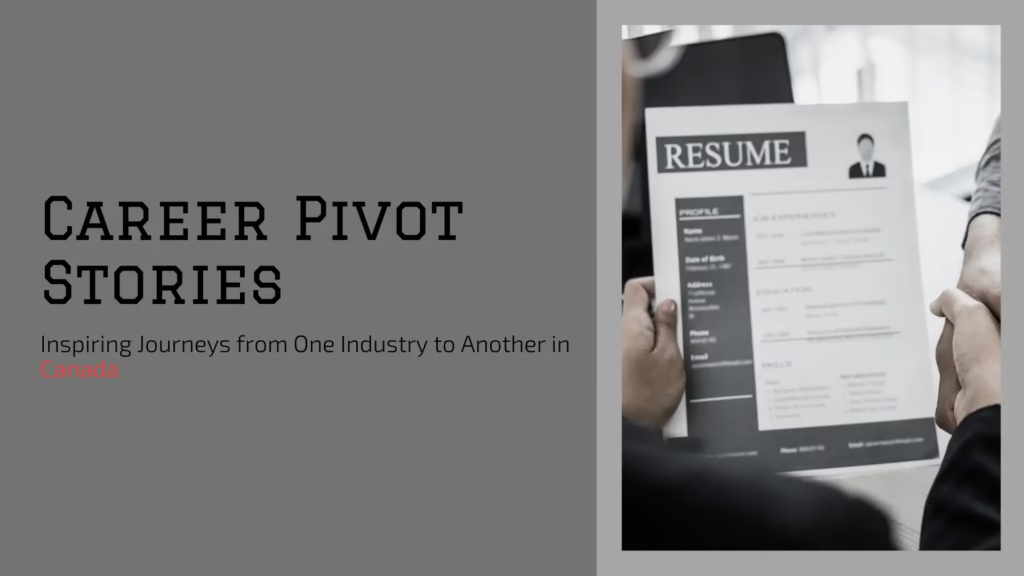
Introduction In today’s fast-evolving job market, career pivots have become more common than ever, especially in Canada. Whether driven by automation, industry decline, or personal aspirations, Canadians are exploring new professional avenues that better align with their skills and goals. But pivoting careers isn’t as simple as updating a LinkedIn profile; it requires strategic planning, targeted resumes, and a clear understanding of transferable skills. At OMY Resumes, we specialize in guiding professionals through these transitions. In this blog, we explore real-life career pivot stories, providing actionable insights and strategies for Canadians seeking change. From IT professionals moving into project management to nurses transitioning into healthcare administration, these case studies reveal the keys to a successful career transformation in 2025’s competitive landscape. Understanding Career Pivots in Canada What is a Career Pivot? A career pivot involves moving from one industry or role to a different one, often leveraging transferable skills. Unlike a simple job change, a pivot may require new training, certifications, or strategic resume adjustments to appeal to hiring managers in a new sector. Why It Matters in Canada: Key Trends Driving Career Pivots Common Challenges in Career Pivots IT Specialist to Project Manager Background: John, a Toronto-based IT specialist, wanted to move into project management to leverage his technical expertise and organizational skills. Strategy: Outcome: John secured a project manager role in a leading Toronto tech company within three months. Registered Nurse to Healthcare Administrator Background: Emily, an experienced nurse from Vancouver, sought a role in healthcare administration. Strategy: Outcome: She became a healthcare coordinator, overseeing hospital operations. Even clinical roles can translate into administrative competencies when presented effectively. Finance Analyst to Data Science Background: Raj, a finance analyst in Calgary, wanted to enter the booming field of data science. Strategy: Outcome: Landed a data scientist position in a fintech startup. Tip: Certifications and demonstrable projects significantly boost credibility in tech pivots. Successful Career Pivot Common Mistakes to Avoid Resume Trends 2025 for Career Pivoters Expert Tips for LinkedIn Optimization Canadian Job Market Insights for 2025 Statistical Highlight: According to, demand for healthcare administrators and tech project managers is expected to grow by 15% over the next five years. Strategies to Enhance Transferable Skills Industry-Specific Resume Tips Leveraging Career Consultation Canada A career consultation helps pivoters: Explore for personalized guidance. Interview Preparation for Career Pivots Creating a Personal Brand for a Pivot Mini-Case Study: Marketing Executive to UX Designer Background: Lisa, a Montreal marketing executive, transitioned to UX design. Strategy: Outcome: Hired as a UX designer for a leading Canadian e-commerce company. Leveraging AI Tools in Career Pivots Actionable Checklist for Career Pivot Success Conclusion Career pivots in Canada are increasingly achievable with strategic planning, the right resources, and professional guidance. Whether you’re moving from IT to project management, healthcare to administration, or finance to data science, the key is to highlight transferable skills, tailor your resume and LinkedIn profile, and prepare for
